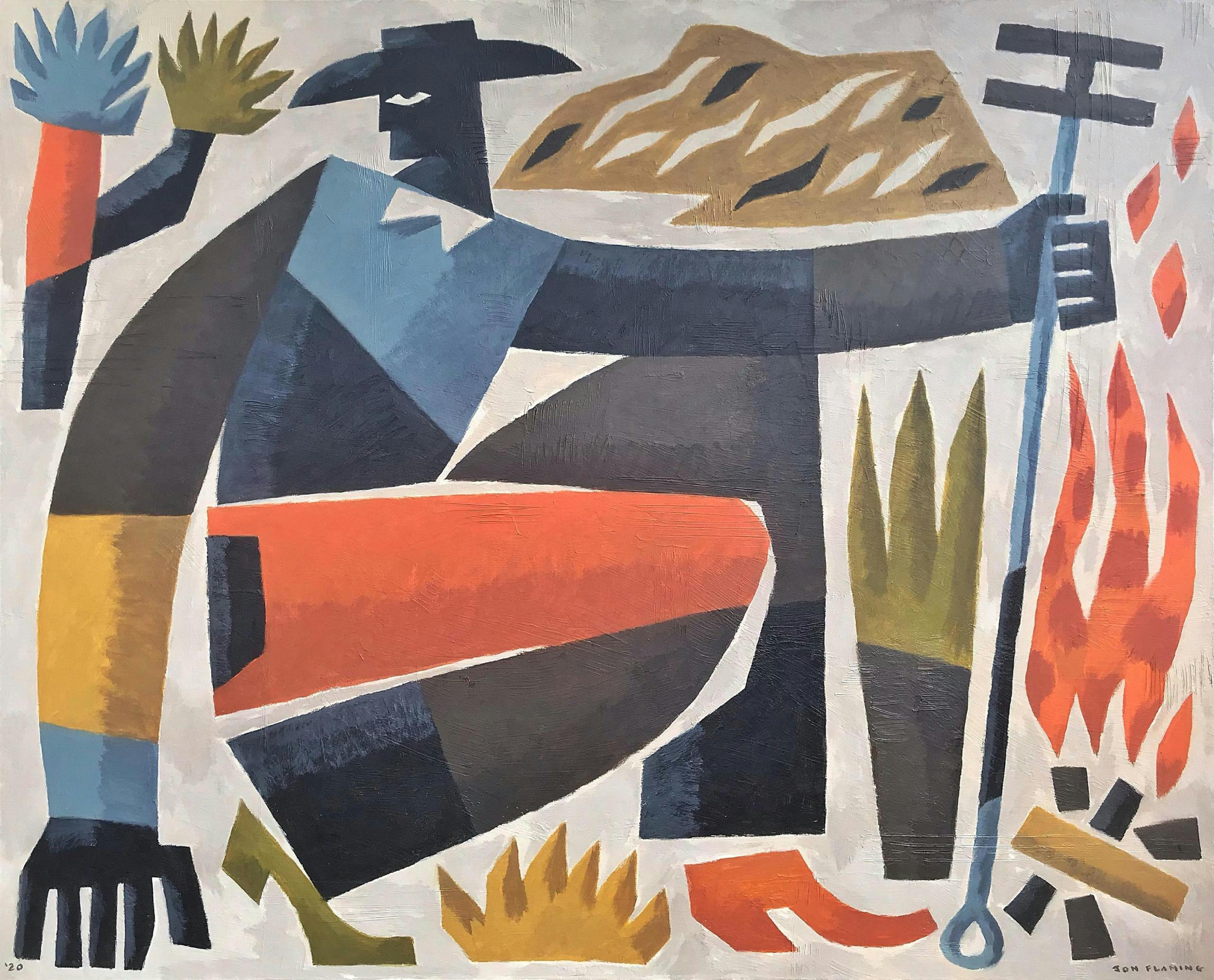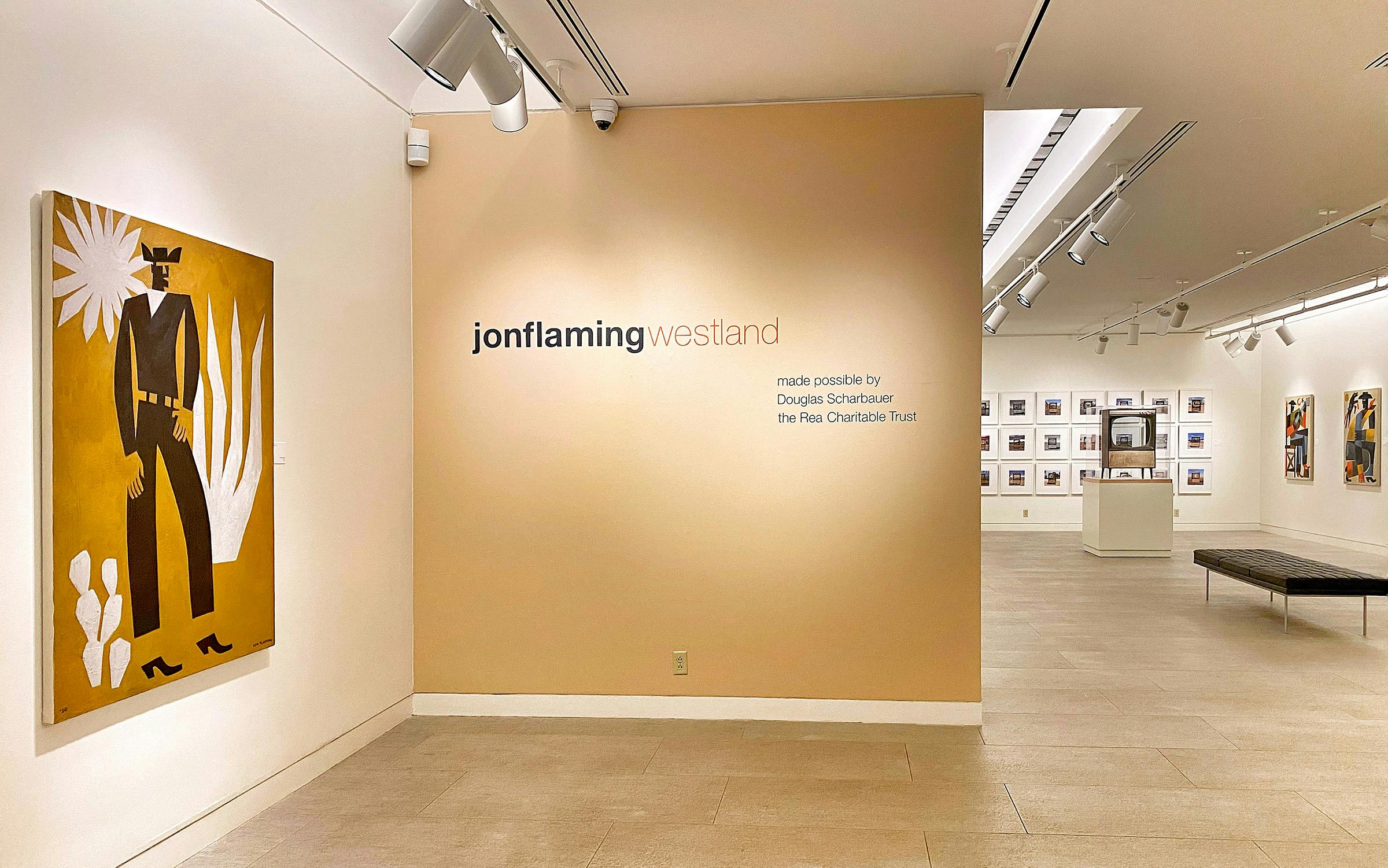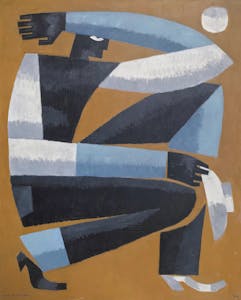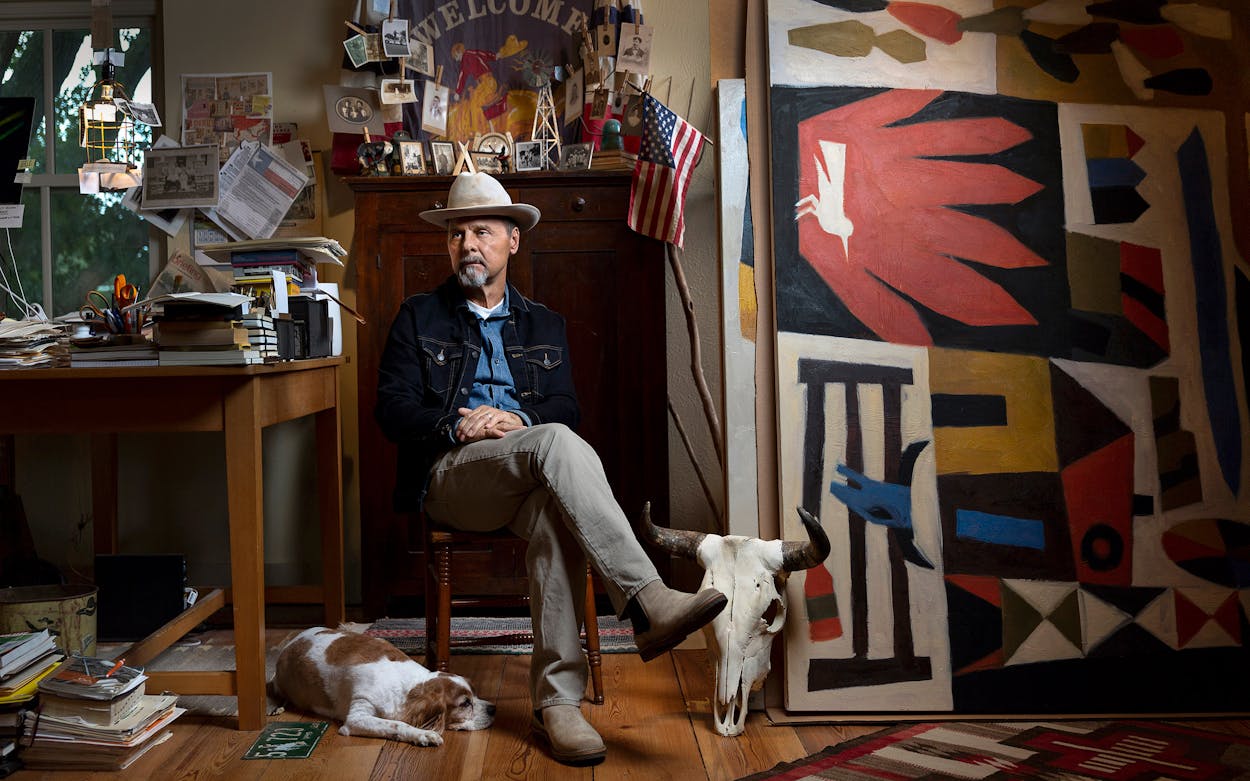Jon Flaming has never looped a lasso over a stampeding steer. He has never pressed a hot branding iron onto a calf’s flank, or mended a barbed wire fence on a sprawling ranch.
But look at his stylized paintings—big, bold canvases featuring geometric cowboys cradling calves, riding horses, and crouching by campfires—and you’ll taste the blowing dust and smell the cow manure. At the same time, his work evokes elements of cubism, modernism, and contemporary design. It’s like a Texan moseyed into an old Works Progress Administration poster, lit up a cigarette, and stared into the future.
“I’m a cowboy, and even though I don’t have a real ranch and I don’t rope cattle or ride horses, that’s what I love and that’s kind of who I am,” he says.
That might be surprising, considering that Flaming—whose work is on display at Midland’s Museum of the Southwest through January 9, and at the Tyler Museum of Art from April 11 to July 11—grew up in suburbia. He was born in Wichita, Kansas, the son of two musicians, and moved to Irving when he was five. But childhood trips to his grandparents’ two-thousand-acre cattle ranch in Kansas left a mark. There, he watched his grandfather work cows and drive tractors, and he dreamed of doing the same. At home, while other kids obsessed about astronauts and rockets, Flaming played out scenes from The Lone Ranger, Fury, and The Rifleman.

As a teenager, he’d occasionally drive a hundred miles in any direction, just to check out the surroundings. “What I saw was the same thing—farmers, blue-collar workers, ranchers—and it hit me again: I love the feel of small-town culture,” he says.
Today Flaming, 58, drives a white Ford F-150 pickup and calls his home in Richardson the Quarter Acre Ranch. The trappings of ranch life, from leather couches to cow skulls, fill every corner of his house. A look around his upstairs studio reveals yellowed snapshots of dairy cows (“Bossy” is scribbled in ink on one) and a worn copy of Will James’s 1927 children’s book Smoky the Cowhorse. Old license plates are nailed to the wood-planked floor. There are paintbrushes, too, and a bourbon bottle is filled with bright pink prickly pear juice, which he uses as paint in some of his work. He always wears boots and a cowboy hat, like the one Paul Newman wore in Flaming’s favorite movie, Hud. “When I first saw that movie, it took me right back to my granddad’s ranch,” he says. “These are guys I saw on the town square or at the gin in town, driving their tractors and feed trucks. It just felt so familiar.”
On a crisp fall day, the artist pats his brown and white dog, Duke, who coughs a little because he has congestive heart failure, and explains how he became an artist. Flaming graduated from Texas State University in 1985 with a design degree. He got married and had three children, then ran a design and branding firm, creating advertisements for clients including Neiman Marcus, American Airlines, and FedEx. But late at night, after he’d put the kids to bed, he’d flip on the lights in the garage, turn up the music, and start painting. “I thought, ‘I can either pull the covers up and go to sleep, or I can get after it,’” he says.

He got after it, eventually drawing interest from Texas galleries and collectors. Three years ago, he dropped the branding work and began painting full time. Post-it notes stuck to his computer monitor remind him to forge on: “Drill a well today,” one says. “Forget the Rules,” another reads. Flaming tries to reimagine and modernize the Western art genre in his work. He cites classic painters of the Old West as his heroes: Frederic Remington, Charles Marion Russell, Maynard Dixon, and William Herbert Dunton. His work shares their sense of nostalgia, but in a less realistic style, often with a wallop of humor thrown in. “A lot of guys chose to emulate and copy and keep that look going on, but that was the last thing I wanted to do,” he says. “That beautiful horse has already been ridden. I want to blaze my own trail.”
Flaming lists among his influences the colorful, blocky work of French artist Henri Matisse, the Postimpressionist paintings of Paul Cezanne, the proto–Pop Art of American modernist painter Stuart Davis, and works by early Texas artists including Otis Dozier, William Lester, and Everett Spruce. He chooses colors inspired by what he sees when he drives down a gravel road, kicking up puffs of earth scorched by sunlight. “Everything I see is filtered through that dust. I see burnt orange, dirty green, ochre yellows, and cream,” he says.
One painting, Savior, depicting a cowboy holding a calf in his arms, is based on the biblical parable of the lost sheep. Flaming once did an entire show, titled “Oil on Canvas,” of paintings related to oil fields. Another exhibit, “Meat,” focused on Texas barbecue.
He also frequently paints Big Tex, the 55-foot animatronic greeter whom Flaming watched go up in flames in 2012 at the State Fair of Texas. He hates the rebuilt version, whose legs, he says, are too short for the rest of his body. (“Originally, he was this tall, lanky drink of water. Now he’s just disproportionate.”) This year, Flaming did a painting called No Fair, after the 24-day celebration of fried food, carnival rides, and Texas culture went drive-through-only because of the pandemic. Much of his work is angular, almost cubist, distilled but powerful. “Creativity is subtraction,” he says. “I’m trying to convey meaning in simplest way possible.”

Flaming creates much of his work by making tiny sketches of ideas in pen or pencil on paper, then scanning them into a computer and enlarging them. There, he tries different colors until he finds a combination he likes, then projects the image onto canvases three or three and a half feet across, which he paints, layering color to create texture. The original oil on canvas pieces, which sell for between $18,000 and $34,000, are one-of-a-kind; he also makes giclée prints.
Flaming likes to use found items, such as rusted beer cans salvaged from behind an old drive-in movie theater or a vintage suitcase discovered at a garage sale. He also dabbles in photography. A 1960s Westinghouse TV with a simulated wood cabinet has become a beloved prop for a series. He sets the boxy TV up on a rural highway, in the desert or in a field, and uses his iPhone to snap pictures. “Everything, for me, is a canvas,” he says.
With a few swoops of a paintbrush, he creates his signature cowboy design, complete with hat and bandanna, which he often splashes on found objects like the pages of a book or vintage flash cards. “It’s basically me, ‘Dude,’” he says of the depiction.
“Dude” is what his grandkids call him, but the word also means a wannabe cowboy. “For a long time, I had this misconception that I couldn’t be a cowboy because I lived in suburbia,” Flaming says. “Then I had this realization that I’m an artist, and I can do what I want.”
- More About:
- Art
- Richardson
- Irving
- Dallas






